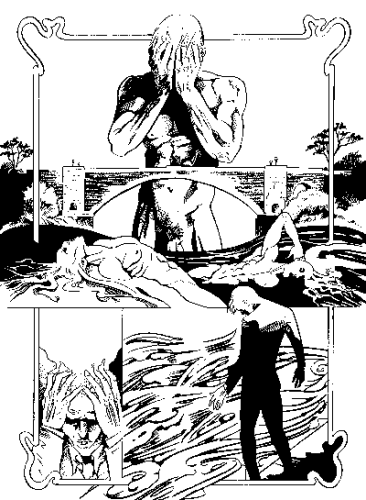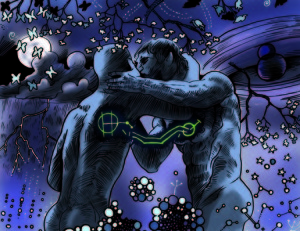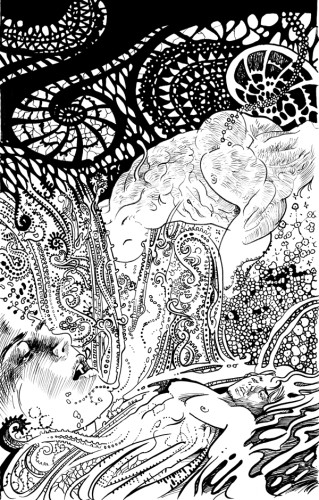Jon Macy: Queer Visual Splendor
Author: Justin Hall
July 8, 2013
“What people don’t get is that adult themes are not just restricted to prose; they are perfectly suited to comics as well.”
Jon Macy began his comics career with the series Tropo and Nefarismo, both part of the black-and-white alternative comics boom of the 1990s. He contributed to queer comics anthologies Meatmen and Gay Comics, as well as gay erotic magazines such as Steam, Bunkhouse, and International Leatherman. His book Teleny and Camille, a graphic novel adaptation of the classic anonymous erotic novel attributed to Oscar Wilde and his circle of friends, won the 2010 Lambda Literary Award for Gay Erotica. His most recent work is Fearful Hunter, an erotic fantasy created as an act of protest against California’s Proposition 8, which won the 2010 Prism Comics Queer Press Grant. He lives and works in the San Francisco Bay Area.
Macy took some time to talk with Lambda Literary about the power of queer comics, creating erotic material, and his Lambda Award winning graphic novel Teleny and Camille.
Jon, you won a Lambda for Gay Erotica in 2010 for Teleny and Camille. What part do you feel that erotica plays in LGBTQ comics?
Well, first let me say that winning a Lambda was a huge validation for me as an artist, and the fact that it was in erotica made it all the more important. I’m a bit of a sex positive activist so winning in that category made me feel that what I was doing had value—which is not the usual message I get when I add erotic content.
I think that sex in our works is something that we all to easily surrender in order to fit in with mainstream publishing, but in the end it just makes things worse. When we willingly sanitize our stories we kill all the love and reality that comes with seeing two men or two women in bed together. Love stories involve sex, and when you reduce it to fully clothed kissing, then you send the world, and your own people, the message that that is all that is allowed us. We need to show our reality, which includes real sex. Of course, how you treat the sex doesn’t have to be sexy.
My main concern when drawing an erotic scene is that it doesn’t look like something from a porn video. Porn does affect our preconceptions of what sex should be like and it banishes all the little mishaps that makes real sex romantic. When you can’t get your pants all the way off, and you just keep going because you really want to be with that person, and you don’t care if you look a fool, that kind of stuff. I do like to portray gay men having sex as a very pretty thing because it is, but I also want it to have personal elements that show it is between real people with feelings.
Do queer cartoonists have a different agenda for erotic material than straight cartoonists?
Well, most straight erotic artists don’t think very much about what their art is saying especially when it comes to women. I think about it a lot. I want to change the world, not reinforce the same old messages. I particularly want to show positive outcomes and happy endings.
Teleny and Camille is a graphic novel adaptation of the famous gay novel attributed to Oscar Wilde and his circle of friends. Clearly, you have an interest in and knowledge of LGBTQ history and culture. How do you see that influencing your work?
What made Teleny so interesting to me was the language. Not just the lush Victoriana, which was beautiful, but also the way they expressed same sex desires before modern gay identity was even formed. They had no vocabulary to draw upon. The words we take for granted today were not in usage yet so the writers really struggled to describe a love that was different and completely unsung. It was so refreshing for me as a modern gay man to just stop and really think about what it means to me when two men come together in a loving way. They were not as burdened by the labels  we give ourselves now. In our rush to ask for ‘exactly’ what we want sexually I think we have willfully limited ourselves to other options. In the past there was more of a sense of brotherhood, more forgiveness and acceptance of our collective deviations from the norm.
we give ourselves now. In our rush to ask for ‘exactly’ what we want sexually I think we have willfully limited ourselves to other options. In the past there was more of a sense of brotherhood, more forgiveness and acceptance of our collective deviations from the norm.
To answer your question, it was the freedom I felt from these writers challenging me to be free as well.
If these Victorian writers were creating a vocabulary for same-sex attraction that hadn’t really existed before in prose, do you feel like a similar project either has been done, or is now underway, for a specifically comics vocabulary for queerness?
Yes, a visual vocabulary specifically for queers is being crafted now with every new graphic novel. We can only see it when looking back, as it takes us in and we just experience it as readers and don’t analyze. I will say that the underpinnings of our society will be revealed in graphic novels, as it is the last bastion of unincorporated free speech. Cartoonists work alone and they have the unique opportunity now to speak their minds without filters because they are under the radar.
Does the comics medium, with its visual components, abstracted manipulations of time, and other singular characteristics, have its own unique intersection with queer themes and depictions?
Comics is a visual medium and so it can be taken in very quickly. That is the reason it is often targeted in bans, because you can have twenty pages of rape in a novel but you would have to read that, but one panel of a comic is readily visible in a second. Censors are lazy and comics make it easy for them.
What people don’t get is that adult themes are not just restricted to prose; they are perfectly suited to comics as well. Queer themes are effective because queer readers enjoy comics. Queer readers are eager and clever and don’t hide from difficult concepts.
Tell us about how you got into making comics. What’s your career path been like as a cartoonist? And do you have any advice for new cartoonists who want to create queer-themed graphic novels, comic books, strips, and webcomics?
I started making comics as a teenager, but I didn’t get published until I was twenty-five. That came about by going to conventions and hanging out with as many cartoonists and editors as I could, and just being real to them. Not selling myself. I knew what I had in me, but my skills hadn’t gotten there yet. I just tried to only present my best work at the time, and always follow through on things that I promised.
I do feel that queer cartoonists are powerful. Our stories only seem small to the mainstream world when in fact we are shaping our culture and identity. My hope is that we show happy moments free of shame, and great potential that the next generation can visualize and strive for. If the world isn’t to your liking, show another one that is right. It can make a difference to someone just knowing that there are others who feel the same out there. Comics can tap into and express emotions that other mediums cannot. Quiet moments that slip under the radar. These are universal and bring us together. These are weapons of change.
What’s next for Jon Macy? What are you working on right now, and what’s in the pipeline?
Right now I’m finishing up my graphic novel Fearful Hunter, which is an exploration of what gay male monogamy means to me, and what mental illness in a gay relationship can be like for a caretaker. Very soon I will be starting a project I have wanted to do for twenty years. An imagining of what a world based on music and the arts would be like, called Sebaceous Funk.




